
Castile and León, open royal crown
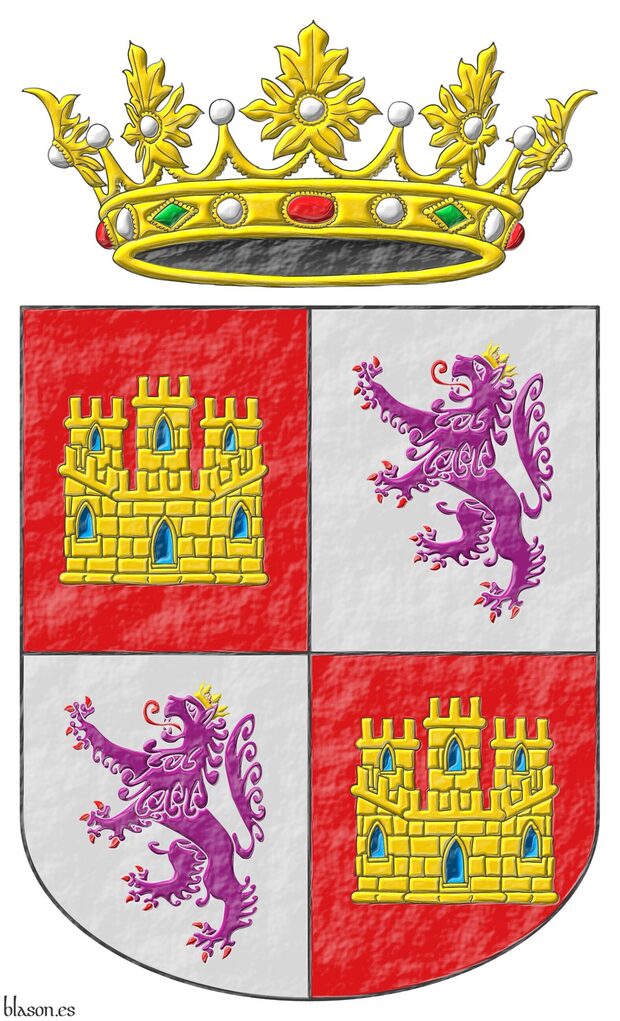
Quarterly: 1 and 4 Gules, a castle triple towered Or, port and windows Azure, masoned Sable; 2 and 3 Argent, a lion rampant Purpure, armed and langued Gules, crowned Or. Crest: An open royal crown Or.
Escudo cuartelado: 1o y 4o de gules, un castillo de oro, aclarado de azur, mazonado de sable; 2o y 3o de plata, un león rampante de púrpura, armado y lampasado de gules, coronado de oro. Timbrado de una corona real abierta.
Pre-existing arms interpreted by me as follows: the shield of arms has a rounded (semicircular) base; the quarterly field, the two castles and the two lions are illuminated; the lion and its crown are outlined in the colour of the field; the open royal crown and the castle are outlined in Sable, in the case of the castle because it is masoned; and the whole has a painted plaster finish.
In [Medél, R.; 1846; plate 10, illustration 4] his interpretation of the arms of Castile and León can be seen.
For the expression «a Castle triple towered» in the English blazon, I have followed [Burke, B.; 2009; pages 12, 27, 41, 51, 76, 104, 106, 109, 150, 159, 171, 189, 200, 226, 273, 281, 282, 287, 322 and others], where it is used more often with a hyphen «triple-towered» and less often without a hyphen «triple towered», which is the form I have chosen.
Blazon keywords: Quarterly, Gules, Or, Azure, Sable, One, Castle, Port and windows, Masoned, Argent, Purpure, Lion, Rampant, Armed, Langued, Crowned, Crest, Open royal crown and Crown.
Style keywords: Rounded, Illuminated and Gesso.
Classification: Interpreted, Civic, Coat of arms, Kingdom of Castile and Leon and Canting.
Bearer: Castile and León.


Castile and León, framed
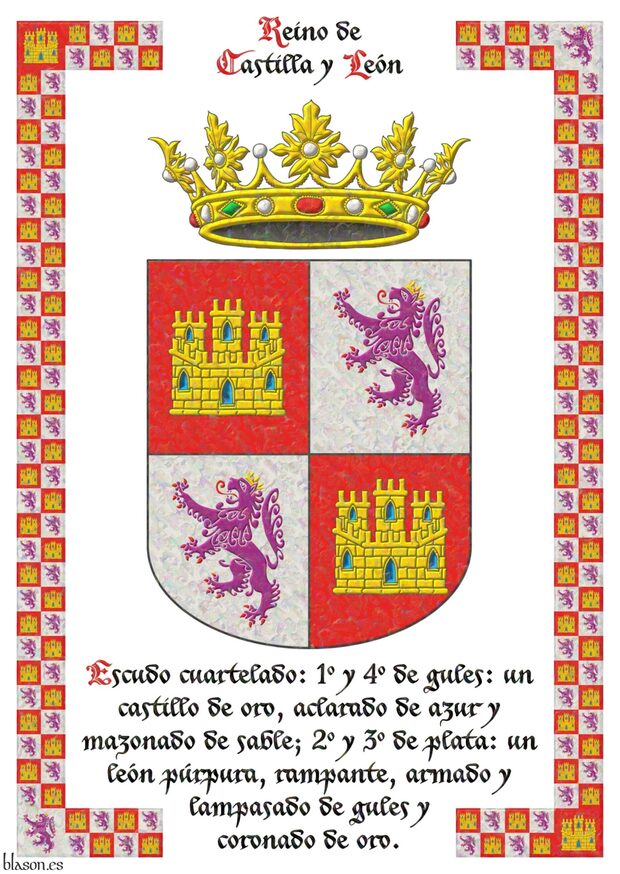
Quarterly: 1 and 4 Gules, a castle triple towered Or, port and windows Azure, masoned Sable; 2 and 3 Argent, a lion rampant Purpure, armed and langued Gules, crowned Or. Crest: An open royal crown Or.
Escudo cuartelado: 1o y 4o de gules, un castillo de oro, aclarado de azur, mazonado de sable; 2o y 3o de plata, un león rampante de púrpura, armado y lampasado de gules, coronado de oro. Timbrado de una corona real abierta.
Arms of the Kingdom of Castile and León created by me as follows: the shield of arms has a rounded (semicircular) base; the quarters are illuminated in flat tinctures Argent and Gules; the castles, lions and crown are illuminated; the lion and its crown are outlined in the colour of the field; the open royal crown; the royal Castilian castle is masoned, that is, outlined in Sable; the whole has an iridescent finish; and the owner, the shield and its blazon are framed within a border representing the arms of the Kingdom, this frame resulting from the combination of 76 small castles and 2 large ones at the corners with 76 small crowned lions and 2 large lions at the other corners;
In the armorial [Urfé; 15th century; page VIII of the index and page 140 of the contents], reference is made to and the arms of Castile and its kings are blazoned in French, describing its castle and its purple lion crowned Or and rampant.
Blazon keywords: Quarterly, Gules, Or, Azure, Sable, One, Castle, Port and windows, Masoned, Argent, Purpure, Lion, Rampant, Armed, Langued, Crowned, Crest, Open royal crown and Crown.
Style keywords: Rounded, Illuminated and Iridescent.
Classification: Interpreted, Civic, Frame, Kingdom of Castile and Leon and Canting.
Bearer: Castile and León.


Banner of Castile and León
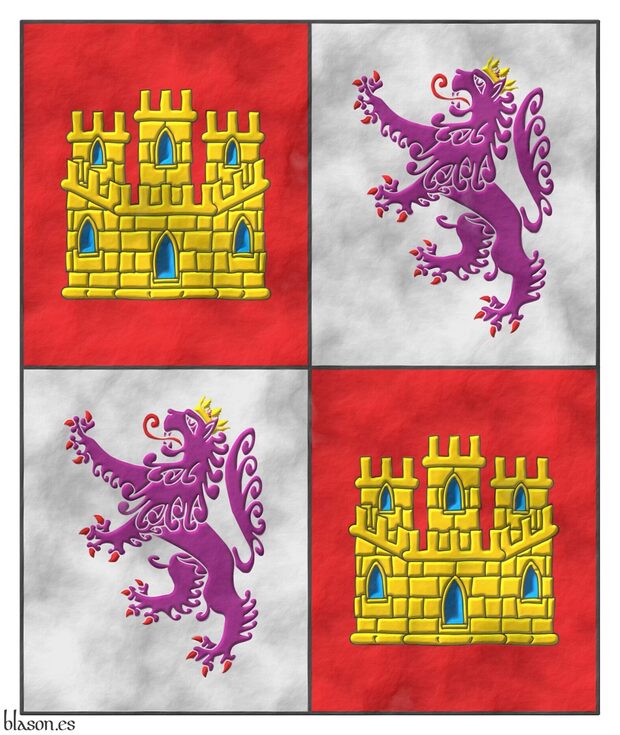
Banner Quarterly: 1 and 4 Gules, a castle triple towered Or, port and windows Azure, masoned Sable; 2 and 3 Argent, a lion rampant Purpure, armed and langued Gules, crowned Or.
Pendón cuartelado: 1o y 4o de gules, un castillo de oro, aclarado de azur, mazonado de sable; 2o y 3o de plata, un león rampante de púrpura, armado y lampasado de gules, coronado de oro.
Banner interpreted by me as follows: a rectangle with proportions between its width and height of 5x6; the field is illuminated in flat tinctures Gules and Argent; the two castles and the two lions are illuminated; the lion and its crown are outlined in the colour of the field; the castle is masoned in Sable; and the whole has a parchment-like finish.
In the armorial for the coronation of [Edward IV of England; 1461; column 2, row 25] a banner of these characteristics can be found, the reason for which was Edward IV’s aspiration to this kingdom, an aspiration inherited from his predecessors.
This armorial was produced by different artists, and the one who was assigned to paint the banner of Castile and León seems to have depicted the lions in gold, although this gold is not as yellow as that which colours the castles, whose castles have two very small windows and a door Azure. Because of this difference in shade between lions and castles, one might consider the hypothesis of a degradation of an original purple tincture into an ochre hue.
At the beginning of the armorial these lions also appear in an equestrian representation of Edward IV, where a pinkish tone could recall an original purple and, therefore, support the hypothesis of such degradation.
Finally, there is a third appearance of these lions in another banner combining the arms of Castile and León with those of England, where the colour of the lions more closely resembles that of the banner than that of the equestrian representation.
Blazon keywords: Quarterly, Gules, Or, Azure, Sable, One, Castle, Port and windows, Masoned, Argent, Purpure, Lion, Rampant, Armed, Langued and Crowned.
Style keywords: Illuminated, Rectangular and Old parchment.
Classification: Interpreted, Civic, Flag, Banner of arms, Kingdom of Castile and Leon and Canting.
Bearer: Castile and León.


Castile and León on parchment
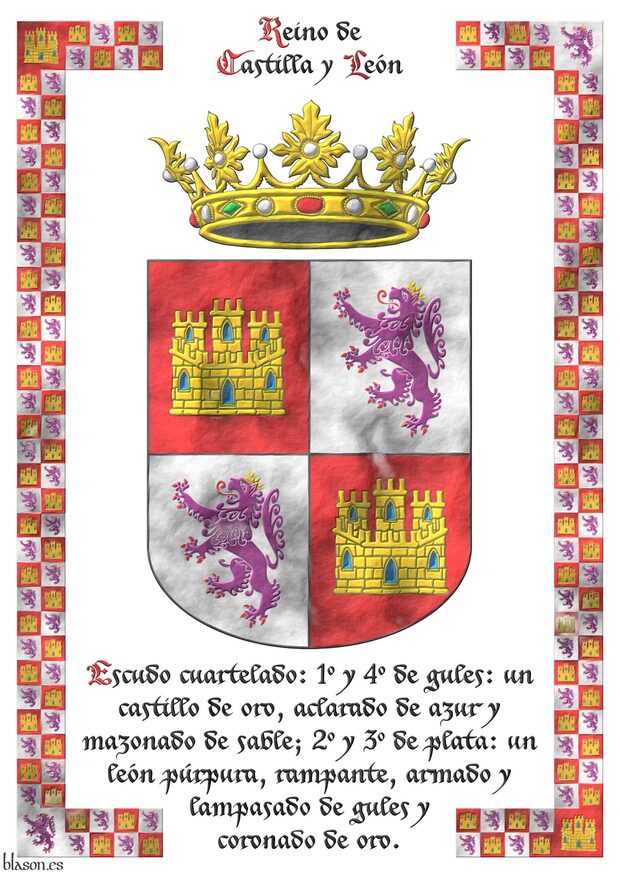
Quarterly: 1 and 4 Gules, a castle triple towered Or, port and windows Azure, masoned Sable; 2 and 3 Argent, a lion rampant Purpure, armed and langued Gules, crowned Or. Crest: An open royal crown Or.
Escudo cuartelado: 1o y 4o de gules, un castillo de oro, aclarado de azur, mazonado de sable; 2o y 3o de plata, un león rampante de púrpura, armado y lampasado de gules, coronado de oro. Timbrado de una corona real abierta.
Arms of the Kingdom of Castile and León which I have interpreted as follows: the shield has a rounded (semicircular) base; the quarters are illuminated in flat tinctures Argent and Gules; the castles, lions and crown are illuminated; the lion and its crown are outlined in the colour of the field; the open royal crown; the royal Castilian castle is outlined in Sable, which is said to be masoned; the owner, the shield and its blazon are framed within a border also representing the arms of the Kingdom, this frame being formed by 76 small castles and 2 large ones in two corners, and 76 small crowned lions and 2 large ones in the other two corners; and the whole set appears as if illuminated upon an old parchment.
Blazon keywords: Quarterly, Gules, Or, Azure, Sable, One, Castle, Port and windows, Masoned, Argent, Purpure, Lion, Rampant, Armed, Langued, Crowned, Crest, Open royal crown and Crown.
Style keywords: Rounded, Illuminated and Old parchment.
Classification: Interpreted, Civic, Frame, Kingdom of Castile and Leon and Canting.
Bearer: Castile and León.


Castile and León, history of the coat of arms
This heraldic catalogue consists of 14 pages in DIN A4 format; 10 of the pages are framed in Gules and Argent with the arms of the kingdom, combining 78 castles with 78 crowned lions, 152 of which are small figures and 4 large ones; it includes 11 different heraldic elements for colour printing; and the texts are in Sable with highlights in Gules.
Blazon keywords: Quarterly, Argent, Purpure, Gules, Or, Azure, Sable, One, Castle, Port and windows, Masoned, Lion, Rampant, Armed, Langued and Crowned.
Classification: PDF, Created, Civic, Catalogue, Heraldic document, Kingdom of Castile and Leon and Canting.
Bearer: Castile and León.


Fernández de Córdoba y Carrillo, Diego
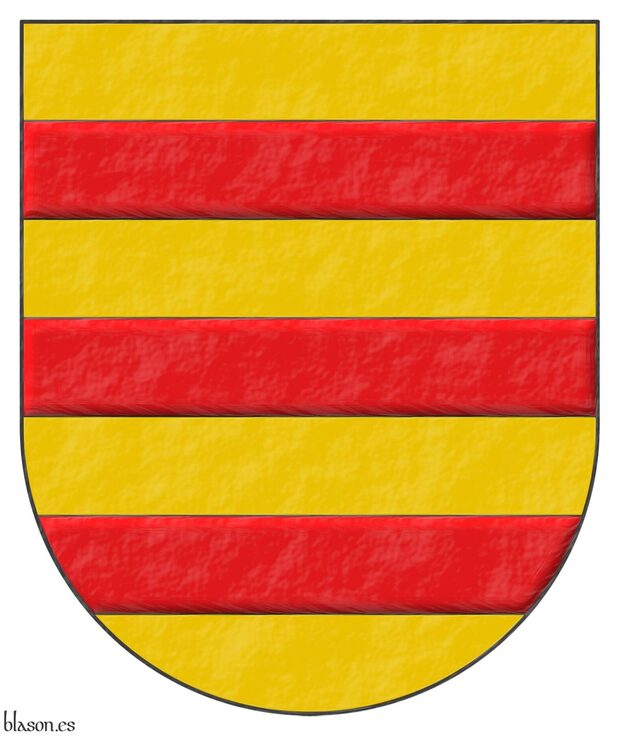
Marshal of Castile, first Lord of Baena and plenipotentiary ambassador to the court of Portugal (1355–1435).
Or, three fesses Gules.
Escudo de oro, tres fajas de gules.
Coat of arms del que fue mariscal de Castilla interpreted as follows: the shield has a semicircular (round) base; the field is illuminated in flat metal Or; its three fesses illuminated in Gules y outlined in Sable; y el conjunto con un plastered finish.
He served under the kings John I of Castile, Henry III of Castile, and John II of Castile.
These three bars of the Fernández de Córdoba lineage are found, for example, in the first quarter of the coat of arms of Gonzalo Fernández de Córdoba y Enríquez de Aguilar, known as *El Gran Capitán*.
Blazon keywords: Without divisions, Or, Fess and Gules.
Style keywords: Illuminated, Outlined in sable, Semi-circular and Gesso.
Classification: Interpreted, Personal, Coat of arms and Kingdom of Castile and Leon.
Bearer: Fernández de Córdoba y Carrillo, Diego.
Blazon equivalent to: Berry of Molland.


![Ver [Burke, B.; 1842] en referencias bibliográficas. Libro abierto, hojas de plata, filo de oro, guardas de gules, tapas de sable.](../css/Libro.Bibliografia.png)
Burke, B.; 1842
Sir Bernard Burke, C. B., LL. D., Ulster King of Arms, «The General Armory of England, Scotland, Ireland and Wales; Comprising a Registry of Armorial Bearings from the Earliest to the Present Time», Harrison, London, 1842.
Sir Bernard Burke, C. B., LL. D. (1814-1892), also cited as John Bernard Burke, was a British genealogist. He was son of the genealogist John Burke (1787–1848). In 1853, Sir Bernard Burke was appointed Ulster King of Arms.
I use to consult [Burke, B.; 1989] and [Burke, B.; 2009].
Bibliographical reference of century XIX.
Classification: In black and white and English language.
The author is Burke, Bernard.
The following articles cite this bibliographic reference:
External resource:


Sancho IV of Castile
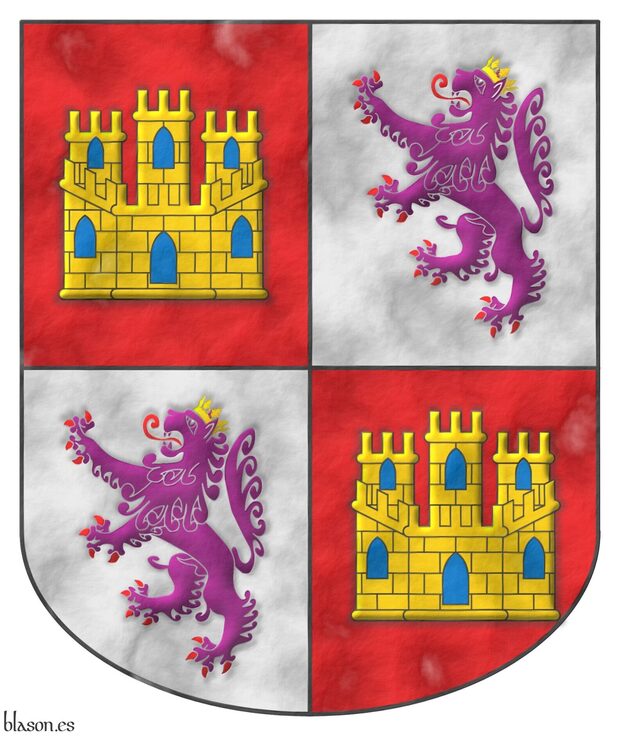
Known as the Brave, king of Castile and León from 1284 to 1295.
Quarterly: 1 and 4 Gules, a castle triple towered Or, port and windows Azure, masoned Sable; 2 and 3 Argent, a lion rampant Purpure, armed and langued Gules, crowned Or.
Escudo cuartelado: 1o y 4o de gules, un castillo de oro, aclarado de azur, mazonado de sable; 2o y 3o de plata, un león rampante de púrpura, armado y lampasado de gules, coronado de oro.
Pre-existing arms interpreted by me as described below: the shield of arms has a rounded (semicircular) base; the field, the two castles and the two lions are illuminated; and the whole has a parchment-like finish.
Blazon keywords: Quarterly, Gules, Or, Azure, Sable, One, Castle, Port and windows, Masoned, Argent, Purpure, Lion, Rampant, Armed, Langued and Crowned.
Style keywords: Rounded, Illuminated and Parchment.
Classification: Interpreted, Personal, Coat of arms and Kingdom of Castile and Leon.
Bearer: Sancho IV of Castile.

Continue with: Sancho IV of Castile, open royal crown.
-
Language
-
Categories of heraldry
-
Divisions of the field
- Without divisions
- Party per pale
- Party per fess
- Party per bend
- Party per bend sinister
- Tierce
- Tierce sinister
- Tierced per pale
- Tierced per fess
- Tierced per bend
- Tierced pallwise inverted
- Quarterly
- Quarterly per saltire
- Gyronny
- Party per fess, the chief per pale
- Party per pale, the sinister per fess
- Party per fess, the base per pale
- Party per pale, the dexter per fess
- Chapé
- Chaussé
- Embrassé
- Contre-embrassé
- Party per chevron
- Enté
- Enté en point
- Flanched
-
Metals
-
Colours
-
Furs
-
Other tinctures
-
Ordinaries and sub-ordinaries
-
Diminutives of the ordinaries
-
Other charges
-
Inanimate charges from Nature
Atom, Crescent, Diamond, Emerald, Estoile, Increscent, Lightning flash, Moon, Mount, Mullet, Mullet of four points, Orbital, Plough of Ursa Major, Rainbow, Ray of the sun, River, Sea, Snowflake, Sun, Sun in splendour, Sun of May, Trimount and Water.
-
Vegetal charges from Nature
Acorn, Apple, Apple tree, Ash, Bluebonnet, Camellia, Chrysanthemum, Cinquefoil, Cornflower, Dogwood flower, Double rose, Elm, Fleur de lis, Flower, Holm oak, Hop cone, Kapok tree, Laurel, Lily, Linden, Lotus flower, Madonna lily, Oak, Olive tree, Palm tree, Pomegranate, Poplar leaf, Rose, Shamrock, Sunflower, Thistle, Tree, Tulip, Vine and Wheat.
-
Animal charges from Nature
Badger, Bald eagle, Barbel, Barn owl, Bear, Beaver, Beetle, Bighorn sheep, Blackbird, Boar, Brach hound, Bull, Doe, Dog, Dolphin, Dove, Eagle, Elephant, Falcon, Fish, Flame, Fly, Fox, Frog, Goat, Goldfinch, Goose, Heron, Horse, Hummingbird, Jaguar, Lark, Leopard, Lion, Lion passant, Lion rampant guardant, Lioness, Lynx, Male figure, Martlet, Merino ram, Owl, Panther, Parrot, Peacock, Pelican, Pelican in her piety, Puffin, Quetzal, Raven, Roe deer, Rooster, Savage, Seagull, Serpent, She-wolf, Stag, Starling, Tyger, Vulture, Warren hound and Wolf.
-
Parts of natural charges
Arm, Beak, Branch, Caboshed, Chest, Claw, Covert, Dorsal fin, Eagle claw, Ermine spot, Escallop, Feather, Foot (palmiped), Foreleg, Forepaw, Hand, Head, Heart, Hoof, Leaf, Neck, Ostrich feather, Palm frond, Paw, Roe deers' attires, Shoulder, Sprig, Stags' attires, Stem, Swallow-tail, Tail, Tail addorsed, Tail fin, Talon, Tooth, Trunk, Trunk (elephant), Two hands clasped, Two wings in vol, Udder, Wheat spike, Wing and Wrist.
-
Artificial charges
Ace of spades, Anchor, Anvil, Arch, Arm vambraced, Armillary sphere, Arrow, Axe, Bell, Bell tower, Beret, Bonfire, Book, Bookmark, Bow, Bridge, Broken, Buckle, Cannon, Cannon dismounted, Cannon port, Carbuncle, Castle, Celtic Trinity knot, Chain, Chess rooks, Church, Clarion, Clay pot, Closed book, Club, Comb, Compass rose, Conductor's baton, Cord, Covered cup, Crozier, Crucible, Cuffed, Cup, Cyclamor, Dagger, Double vajra, Drum, Ecclesiastical cap, Fanon, Federschwert, Fleam, Four crescents joined millsailwise, Galician granary, Garb, Gauntlet, Geometric solid, Grenade, Halberd, Hammer, Harp, Host, Hourglass, Key, Key ward, Knight, Knot, Lantern, Letter, Line, Loincloth, Menorah, Millrind, Millstone, Millwheel, Monstrance, Mortar, Mullet of six points pierced, Nail, Non-classic artifact, Norman ship, Number, Oar, Oil lamp, Open book, Page, Pair of scales, Parchment, Pestle, Piano, Plough share, Polish winged hussar, Port, Portcullis, Potent, Quill, Ribbon, Rosette of acanthus leaves, Sabre, Sackbut, Sail, Scroll, Scythe, Sheaf of tobacco, Ship, Skirt, Spear, Spear's head, Stairway, Star of David, Step, Sword, Symbol, Tetrahedron, Torch, Tower, Trident, Trumpet, Turret, Two-handed sword, Wagon-wheel, Water-bouget, Wheel, Winnowing fan and With a turret.
-
Immaterial charges
Angel, Archangel, Basilisk, Dragon, Dragon's head, Garuda, Golden fleece, Griffin, Heart enflamed, Mermaid, Our Lady of Mercy, Ouroboros, Paschal lamb, Pegasus, Phoenix, Sacred Heart of Jesus, Saint George, Sea-griffin, Trinity, Triton, Unicorn, Winged hand and Wyvern.
-
External elements
-
Heraldic creations
-
References
-
Formats
-
Keywords on this page
Port and windows, Parchment, Old parchment, Armed, Azure, Flag, Bibliography, Castile and León, Castle, Catalogue, Crest, Crown, Open royal crown, Crowned, Created, Quarterly, Outlined in sable, Heraldic document, In black and white, Gesso, Coat of arms, Fess, Fernández de Córdoba y Carrillo, Diego, Personal, Gules, Illuminated, Interpreted, Iridescent, Langued, English language, Lion, Lineage, Frame, Masoned, Semi-circular, Or, PDF, Canting, Banner of arms, Argent, Without divisions, Civic, Purpure, Rampant, Rounded, Kingdom of Castile and Leon, Sable, Sancho IV of Castile and One.